#Sturmpanzerwagen A7V
Text
Starting this off with my favourite tank, the German Sturmpanzerwagen A7V!!
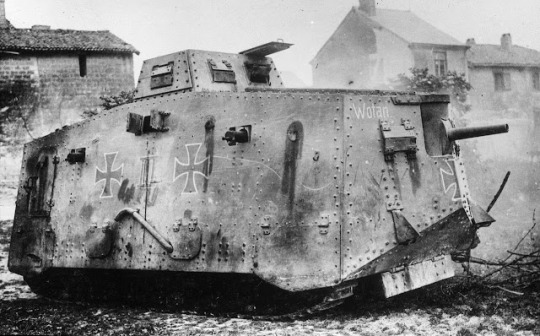
Why on earth is this chunky monstrosity my favourite tank out of every tank ever made? Because it is absolutely awful at everything and I think that's very funny.
The A7V was the first tank ever made by the Germans, it was invented in 1917 and used in the later stages of WW1. This thing was massive, measuring at about 8 metres long (26 feet), 3 metres wide (almost 10 feet), and 3.3 metres tall (almost 11 feet). It also weighed about 36 tons when in combat which caused a lot of problems, namely for its speed and traversal capabilities.
Soldiers could outpace this thing ON FOOT. The A7V had a top speed of only 14 km/h (9 miles/h), which is already pretty slow, but that speed was drastically reduced if the terrain was even a little bumpy, going down to only 6 km/h (4 miles/h). And that was if this thing managed to not break down or get stuck in a shallow ditch.
The Sturmpanzerwagen A7V was highly prone to suddenly failing due to the fact that the tank's track base was literally pulled out of a tractor. It was not a suitable base for a tank at all and made the whole thing unsafe in certain conditions, leading to frequent breakdowns.
The A7V also had only a few inches of ground clearance. This meant that it had issues going over even a slight bump in the ground. It would also fall into ditches constantly. The overhanging and heavy front end meant that if it went over an edge even a little too far, there was no stopping it. Judging by the number of pictures of this thing getting stuck, this was a fairly common occurence.
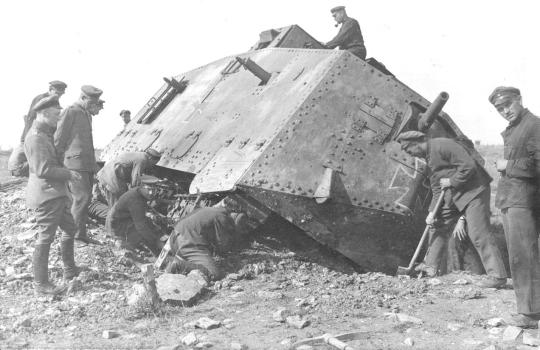
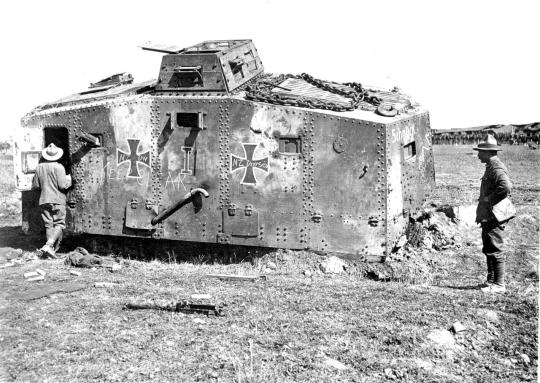
Let's not forget to mention that the driver of the A7V had a 10 meter long blindspot at all times. They were sat in that little box on top of the tank and had the front end of the tank blocking their view!! How anyone thought this was a good idea absolutely baffles me.
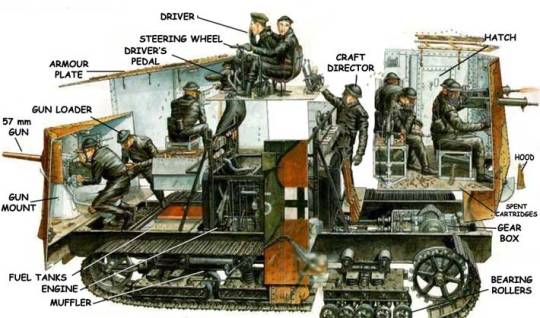
That's a lot of soldiers just to man one tank. This thing required a crew of 18 or more to operate, but due to its absolutely awful armour, none of them were safe!! The Sturmpanzerwagen A7V had near vertical armour plating, which made it highly susceptible to direct hits. Many tanks nowadays have angled plating for this exact reason, because vertical armour does not deflect bullets properly!
Interestingly, the Sturmpanzerwagen A7V was one of the tanks involved in the first ever recorded tank on tank duel! On the 24th of April in 1918, three A7Vs went up against three Brittish Mk. IVs.
The A7Vs lost of course. Brittish tanks, while still clunky, were much better than German tanks at this time.
Only twenty A7Vs were produced before WW1 ended. Many of them were either destroyed during the war, or scrapped afterwards due to their flawed design. Today only one Sturmpanzerwagen A7V remains, the 506 Mephisto, and it's in Australia of all places. The Mephisto was abandoned on the battlefield by its crew and later taken as a trophy by Australian soldiers. It now resides in the Queensland museum in Brisbane.

Sources: X , and my brain, I have this thing's history memorized.
#WW1#History#WW1 history#WW1 tanks#tankposting#tanks#tank#sturmpanzerwagen#sturmpanzerwagen a7v#german tanks
10 notes
·
View notes
Photo
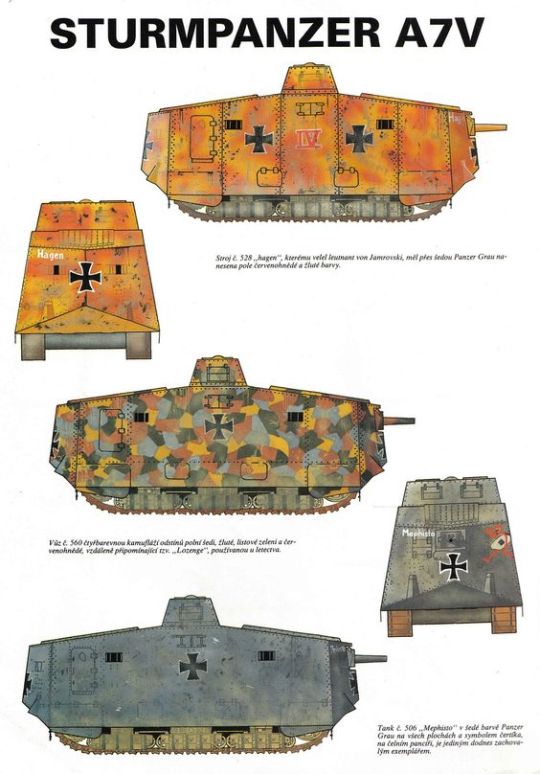

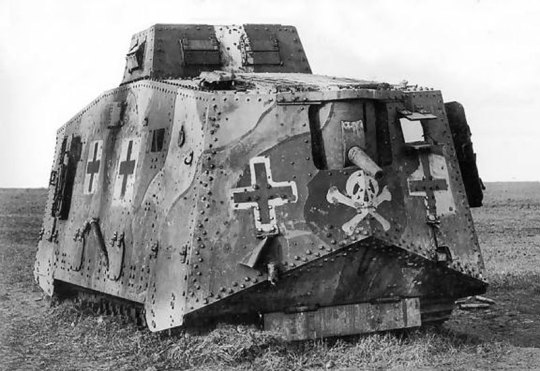
Sturmpanzerwagen A7V
#A7V#heavy tank#The A7V was a heavy tank introduced by Germany in 1918 during World War I#xx century#20th century#the great war#the first world war#war#Sturmpanzerwagen A7V#German heavy tank#WW I#WWI#WW 1
51 notes
·
View notes
Text
Sturmpanzerwagen A7V

A7V a WW1 German tank armed with 57mm Maxim-Nordenfeld cannon and 6x MG08 maschineguns. Capable of reaching speeds ranging from 4 to 8 km/h in offroad conditions.
It was 3,40m tall, 3,10m wide and 8m long, in short → quite huge. Only 20 were made between 1917 and 1918


I decided to try and recreate this wonderful machine in sprocket, and it may not be perfect but it sure did complete the WW1 scenario.





6 notes
·
View notes
Text
Shoutout to Gretchen, the Sturmpanzerwagen A7V who transed their gender.
1 note
·
View note
Photo



I've modeled WWI German Tank Sturmpanzerwagen #A7V. Modeled in Blender rendered in cycles. 🤯 I have a great passion about WW tanks and weapons, this one will be a start of a new series of ww tanks and other weapons. 🚧
The A7V was a heavy tank introduced by Germany in 1918 during World War I. One hundred chassis were ordered in early 1917, ten to be finished as fighting vehicles with armoured bodies, and the remainder as Überlandwagen cargo carriers.
The A7V was 7.34 m (24 ft 1 in) long and 3 m (9 ft 10 in) wide, and the maximum height was 3.3 m (10 ft 10 in). The tank had 20 mm of steel plate at the sides, 30 mm at the front and 10 mm for the roof.
The A7V carried between 40 and 60 cartridge belts for its machine guns, each of 250 rounds, giving it a total of 10,000 to 15,000 rounds. Officially, it carried 180 shells for the 57 mm gun, of which 90 were canister, 54 were armor-piercing, and 36 were high-explosive; in practice, however, A7V crews stowed up to 300 57 mm rounds for combat.
#ww1#worldwar#tank#sturmpanzerwagen#a7v#weapon#vehicle#3d#3dart#3dmodel#hardsurface#digitalart#blender#render
0 notes
Photo

Rare WW1 Sturmpanzerwagen A7V footage. via @gifophunia. Follow, like and reblog!
65 notes
·
View notes
Text
This is the Ford Model 1918 3-Ton tank.

Designed in 1918 by the Ford Motor Company, it was one of the first American tanks ever produced.
The M1918 weighed only 3 tons, as the full name suggests. It was an incredibly small tank, measuring 4.3 metres (14 ft) long, 1.8 metres (6 ft) wide, and 1.8 metres tall, and having just two crew members (one driver, one gunner) in its extremely cramped hull.
Despite its engines having been pulled right out of a Ford Model T and getting discribed as anemic, the M1918 had a fairly quick top speed for the time at 12.8 km/h (8 miles/h)

Those silly arms on the back of the tank help it avoid getting stuck in ditches!
Despite being intended as a light tank, the first two prototypes didn't even have a gun. They were effectively just lightly armoured boxes that you could sit a person in.

The idea behind the M1918 was that it would be used to safely transport soldiers and weaponry onto a battlefield, though it didn't end up being very good at that.
This thing was a death box :D
It was based off of the French Renault FT-17, but is worse in almost every way possible.
When the final design of the M1918 eventually got to have a machine gun, it would still be incredibly limited in its use due to an extremely small range of motion. And although the tank does have angled armoured plating unlike SOME early tanks (looking at you, Sturmpanzerwagen A7V), the armour thickness was only a maximum of half an inch thick, leaving it vulnerable to anti-tank weaponry and concentrated machine gun fire.
On both the FT-17 and the M1918, the engines are located directly behind the crew compartment. The FT-17 has a metal divider between the engines and crew to give them time to escape in case of an engine fire.
The M1918 doesn't!
If you are operating this tank and the engines catch fire, you are dead!
Isn't that wonderful? :D
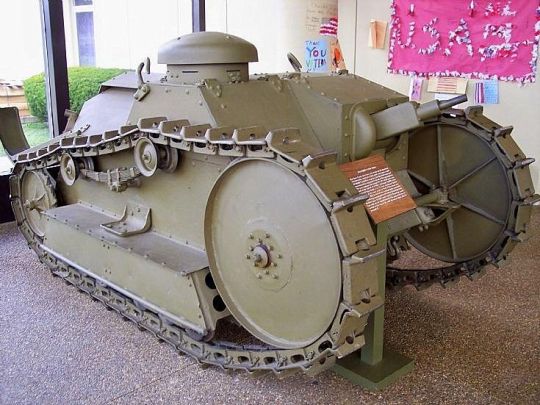
The US Army had a contract with Ford to produce 15 thousand M1918s, though testing proved the use of the tank to be quite limited compared to the readily available FT-17s. Production was halted after WW1 ended, with only 15 tanks being fully complete, and not one of them ever saw combat.
The two surviving M1918s are located in the National Armor and Cavalry Museum in Fort Benning, Georgia and the Ordnance Collection in Fort Lee, Virginia.
Sources: X , X
#This tank is such a deathbox though#I was literally screaming while researching this#history#tankposting#tanks#ww1 history#ww1 tanks#American tanks#American history
45 notes
·
View notes
Photo




The German A7V Sturmpanzerwagen tank, with 20 units made, it was the only German tank produced and used during The Great War.
#A7V Sturmpanzerwagen tank#Tank#the Great War#the First World War#first world war#war machines#War machine#black and white photography#photography#tanks#history#historic
52 notes
·
View notes
Photo








Sturmpanzerwagen A7V
Information about the vehicle
N/A
General specifications
Type: Armored Fighting Vehicle / Tank
Crew: 18;
Communications:
Weight: 33.0 US short tons (29,937 kg)
Length: 8.00 m (26.25 ft.)
Width: 3.06 m (10.04 ft.)
Height: 3.30 m (10.83 ft.)
Suspension: Holt track, vertical springs
Transmission: Adler gearboxes and differentials
Power-plant: 2 x Daimler-Benz gasoline engines developing 100 horsepower each
Fuel Capacity:
Power/weight: 6.5 hp/tonne
Speed: Road: 12.9 km/h (8 mph)/Cross-country: 6.4 km/h (4 mph)
Operational range: Road: 40 km (25 mi)/Cross-country: -km (-mi)
Introduced:
Production Period:
Number built: 20
Place of origin: Imperial Germany
Operators: Imperial Germany
Armament and Ammunition
Main armament
1 x Maxim-Nordenfelt 57mm (2.24 in) main gun (along the front hull facing) (180 rounds; later 300) (another source says 500 rounds)
Secondary armament
6 x 7.92mm Maxim MG08 machine guns
(2 x along the left hull side; 2 x along the right hull side; 2 x along the rear hull facing)
(36,000 rounds; 6,000 rpg = rounds per guns/another source says 30,000 rounds)
Ammunition Type
(Sources: Wikipedia, Tank Encyclopedia, Military Factory, and Google Images)
0 notes
Photo

100th anniversary. On this day in 1919, the Mephisto arrived at its new home at the Queensland Museum, then in Bowen Hills. The Brisbane Courier (23/8/1919) reported, "Amidst, excitement, and in the presence of a fair crowd, the captured German war tank Mephisto arrived at the gates of the Queensland Museum...being drawn by two of the City Council's steam rollers". The Mephisto is the only surviving German A7V Sturmpanzerwagen tank from the First World War. This photograph from our collection shows the arrival of the Mephisto at the old Queensland Museum. It was taken by Brisbane entomologist and amateur photographer Henry Hacker who worked for many years at the Queensland Museum. #ww1 #queensland #brisbane #slqpic #libraries #librariesofinstagram #wwi https://ift.tt/2MxjDQK
3 notes
·
View notes
Photo
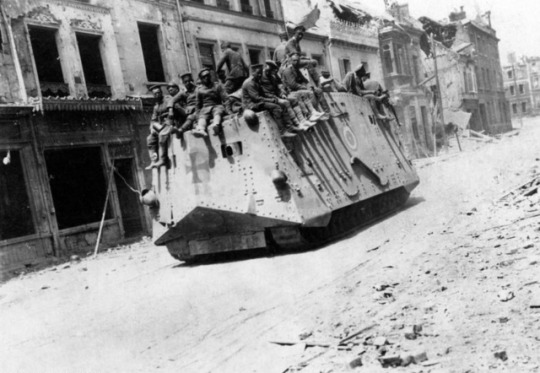
L'offensiva di primavera tedesca, Marzo - Luglio 1918: L'A7V, pt. 1
Un carro tedesco A7V, con alcuni passeggeri in più sul tetto, avanza tra le strade di Roye nel Marzo del 1918.
L'A7V, o più precisamente il Sturmpanzerwagen (Carro armato d'assalto) A7V, è l'unico modello operativo di carro armato costruito dai tedeschi durante la Grande Guerra. L'esercito tedesco infatti, a differenza degli alleati, punta su strategie diverse nel tentativo di sbloccare la staticità della guerra di trincea.
Concepito dopo l'esordio dei carri armati britannici durante la Battaglia di Fleurs-Courcelette nel Settembre 1916, l'A7V entra in produzione nell'Ottobre dell'anno successivo e vede il proprio esordio sul campo di battaglia nel Marzo del 1918 durante l'offensiva tedesca Kaiserschlacht, venendo usato per la prima volta nei dintorni di San Quintino.
Il carro, di cui vengono prodotto solo 23 esemplari – l'unico sopravvisuto, catturato da truppe australiane e spedito in Australia è in esposizione al Queensland Museum – è armato con un cannone frontale Maxim-Nordenfelt da 75 mm e 6 mitragliatrici Maxim disposte sui lati e sul retro del carro.
L'equipaggio del carro varia da un minimo di 16 uomini a un massimo di 26, una cifra sorprendente se si pensa che i carri britannici avevano in media 8 uomini a bordo.
L'armatura è di 30 mm nella parte frontale e di 15/20 mm sui lati, la velocità media di 12 km/h e l'autonomia varia dai 35 a un massimo di 70 km su strada. Il carro ha, per la struttura dei cingolati, la pessima abitudine di sbilanciarsi se costretto a passare su terreni accidentati ed è facile che rimanga bloccato nel passaggio delle trincee. Questo lo rende un carro non particolarmente di successo, quanto meno per la guerra sul fronte occidentale.
The German Spring Offensive, March - July 1918: The A7V Tank, pt. 1
A German A7V tank advancing through the streets of Roye in March 1918.
The A7V, or the Sturmpanzerwagen (Armoured Assault Tank) A7V, is the only operational tank built by the Germans during the Great War. The German army during 1916-1918, unlike the allies, is looking at different ways to unlock the static nature of the trench warfare. Conceived after the debut of the British tanks during the Battle of Fleurs-Courcelette in September 1916, the A7V enters production in October of the following year and sees its debut on the battlefield in March 1918 during the Kaiserschlacht German offensive, being used for the first time in the area near St. Quentin.
The tank, of which only 23 are produced - the only remaining one, captured by Australian troops and sent to Australia is on display at the Queensland Museum - is armed with a 75 mm Maxim-Nordenfelt frontal cannon and 6 Maxim machine guns on the sides and on the back of the vehicle. The tank crew ranges from a minimum of 16 men to a maximum of 26, a surprising figure considering the British tanks normally have an eight men crew.
The armour is 30 mm in the front and 15/20 mm on the sides, the average speed of 12 km/h and the range varies from 35 to 70 km maximum on roads. The tank has, for the structure of its tracks, the bad habit of getting stuck or tip over while crossing rough terrains or enemy trenches. This makes it a not particularly successful tank, at least not for the kind of warfare of the Western Front.
Fonte / Source: Das Bundesarchiv, 183-P1013-316
#Kaiserschlacht#A7V#tanks#carri armati#Tanks in WW1#German Army#Esercito tedesco#1918#Roye#Fronte occidentale#Francia#Western Front#WW1#Prima Guerra Mondiale#Grande Guerra#Great War#First World War#History#Storia#storia militare della Grande Guerra#Military history
8 notes
·
View notes
Text
Steel “Mephistopheles” A7V: only surviving German tank in the First World War
Steel “Mephistopheles” A7V: only surviving German tank in the First World War
The Museum of Queensland (Australia) exhibits a unique exhibit – the last surviving German tank A7V Sturmpanzerwagen from the First World War. Even more surprising, of the 100 years that the tank has turned, 98 years he spent in Queensland.
A total of 21 such tanks were produced simultaneously, and today there is only one “lucky”. We are talking about the A7V (Sturmpanzerwagen) No. 506…

View On WordPress
0 notes
Text
A7V Sturmpanzerwagen aka Brick Shithouse
0 notes
Photo

Rare WW1 Sturmpanzerwagen A7V footage. https://ift.tt/3ttGPkV
0 notes

